The sinking of HMS Wasp, 1884 – A curse, sabotage or human error?
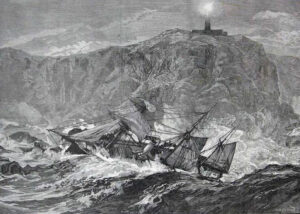
By John Joe McGinley
In September 1884, a royal navy gunboat, on route to carry out an eviction sunk off the coast of Tory Island in Donegal. Smashed on rocks, she sank in just 15 minutes and 52 men perished. The official cause of the sinking was due to negligence, but rumour and folklore persist that sabotage or even a curse could be responsible for the sinking of HMS Wasp.
Ireland in 1884 was a nation in turmoil, the scars of the Great Famine were still raw, two years previously the two most senior politicians in Ireland had been assassinated by the Invincibles in the Phoenix Park and the Land War still raged all across the island.
Background, the Land War

The Land War – a period of often violent agrarian agitation for tenants’ rights -was organised by the Land League, spearheaded by the great Irish patriot Michael Davitt. Against the background of an economic depression since 1879, which saw agricultural prices collapse, the Land league first resisted evictions of tenant farmers and then agitated for three simple but profoundly important demands which became known as the 3 Fs: fair rent, free sale, and fixity of tenure.
On the other side, police and military were often used to enforce evictions order by landlords, who were predominantly Anglo-Irish and often absentees.
The first bout of the Land War largely blew out in 1881-1882, first with Prime Minister Gladstone’s Land Act, which established arbitration courts for tenants and then the ‘Kilmainham Treaty’ of 1882 in which Land League leader Parnell agreed to end a rent strike by tenant farmers in return for the forgiveness of debts of unpaid rent. Nevertheless, disputes and evictions on the land went on.
The HMS Wasp was on its way to help carry out evictions during the Land War when it was wrecked off Tory Island in 1884.
It was in this atmosphere that HMS Wasp began her final journey from her home port of Westort County Mayo to facilitate the eviction of three tenant families on the Island of Inishtrahull, which is the most northerly of the Irish islands lying six miles from Malin Head off the coast of county Donegal. Though uninhabited now, the last residents having left in 1929, the island supported several families in the 1880s as well as a lighthouse.
HMS Wasp
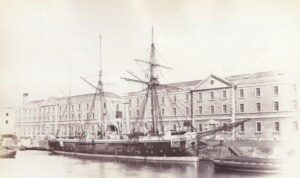
Commissioned on 1 December 1881, HMS Wasp was a Banterer class gunboat built for colonial service throughout the British Empire, to enforce what became known as ‘gunboat diplomacy’.
She was 125 feet long and displaced 465 tons. A 360 Horsepower steam engine gave a top speed of a mere 9.5 knots. This made the Wasp a workhorse rather than a racehorse and the engine was supplemented by a rigging system carried on 3 masts to aid the engine or to replace it when the ship had to conserve coal on long voyages.
HMS Wasp was a Banterer class gunboat built for colonial service throughout the British Empire, to enforce what became known as ‘gunboat diplomacy’.
For their size, these vessels carried a heavy armament. They had two 6-inch 64-pounder muzzle-loading rifled cannon, supplemented by two 4-inch breech-loaders as well as small-calibre Maxim, Gardner or Gatling machine guns. The unsophisticated 6-inch weapons were effective enough for shore bombardment and the vessel’s small size and sailing ability made them useful for colonial duties, for which armour was not required. (1)
The Wasp began her active service, stationed in what was then called Queenstown, which we now know as Cobh, county Cork. Little is known of the Wasps earlier duties, but they are likely to have been fishery inspection and lighthouse provision throughout the Irish coastal waters.
The crew compliment of the Wasp was 60 officers and men. In 1884, as the agitation of the Land war grew, she was moved to Westport to help quell civil disobedience and as a symbol of imperial power in a region which was a hotbed of civil unrest.
Evictions in Donegal
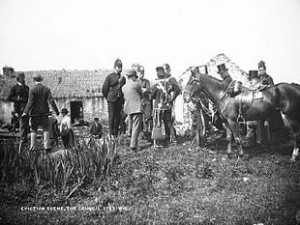
The Wasp commanded by 39-year-old Lieutenant JD Nicholls was ordered to report to Moville in County Donegal to pick up Bailiffs and Police, whom an absentee landlord had ordered to evict 3 tenant families, who had refused, or more likely were unable, to pay their rent on Inishtrahull.
Evictions at the time saw large deployments of armed police and in some cases the military to protect the bailiffs who carried out the actual evictions.
A particularly nasty element of the evictions process was the destruction of the families’ house by battering ram so that they could not return. There are many poignant photographs that show the horror and the brutality of these Land War era evictions.
A final fateful journey
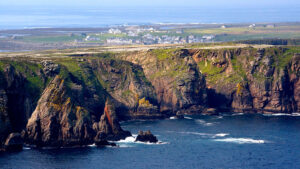
So, on September 21st, 1884 HMS Wasp left Westport to facilitate yet another eviction of poor farming families from their homes. Ironically, this was not the Wasp’s first visit to Inishtrahull, the year previously they had delivered a cargo of seed potatoes to the islanders donated by the Quakers Society of Friends.
In 1883 the Wasp had also delivered the soldiers to Sheephaven who were stationed near Dunfanaghy during the Land League agitation and unrest in County Donegal.
HMS Wasp did not appear to be in a hurry, as she was under sail and her steam engine was turned off. In the early hours of the 22nd of September, she was sailing nine miles off the coast of North West Donegal and the island of Tory.
The year previously the Wasp had delivered a cargo of seed potatoes to the islanders on Tory, donated by the Quakers Society of Friends.
The weather was not classed as stormy or indeed hazardous. It was reported at Mullaghmore in Donegal bay, the nearest meteorological station to Tory Island, that the weather on Sunday night before the disaster was clear with a fresh westerly breeze and sky overcast. (2)
It would later be reported that one of the crew remarked to lieutenant Nicholls before he retired, that the vessel was on course for the Tory Light House and the course should be altered. This could not be changed quickly as the vessel was not under steam but sail. The commanding officer replied that the ship was keeping the course he had marked out on the chart which would prove quite safe. (3)
Nicholls like most of the crew including his other officers were now sleeping in their bunks.
Naval historians have always questioned why the Wasp was sailing inside Tory rather than out to her west, which would have given the ship greater sea room. Also being under sail meant she did not have the manoeuvrability that her steam engine would have provided.
The Wasp was well known in the waters but the navigator on duty was comparatively inexperienced as to the dangers of the Donegal coast and was unfamiliar with the terrain around Tory.
One of the officers ordered a sail to be shortened just before the gun boat struck the rocks, one of the sea men who survived told the officer this action would surely land her upon the rocks but was ordered to shorten the sail and he obeyed. (4)
Collision
 At 3.55am the ship struck a reef directly under the Tory lighthouse.
At 3.55am the ship struck a reef directly under the Tory lighthouse.
The lighthouse stands on the north side of the island. It was erected in 1832. The lighthouse tower is 27m high and the light is 40m above sea level and may be seen for eighteen nautical miles when the atmosphere is clear. Reefs of rocks, portions of which are not visible at high water abound on the west coast in front of the island. (5)
The initial collision broke the hull of the Wasp in two and she began to take on water at an alarming rate. Awoken from his slumber, the ship’s commander, Lieutenant Nicholls ordered the crew to take to the lifeboats. However, disaster struck, and the Wasp hit the reefs again. There was no hope for HMS Wasp as the impact shattered what was left of the ship and within 15 minutes the Wasp was under water with only her masthead protruding from the Atlantic waves.
At 3.55am the ship struck a reef directly under the Tory lighthouse. The commander Nichols and most of the crew were asleep at the time.
Five survivors clung to a spur of the gun boat which had detached from the wreck and were washed up on the rocks. One lucky man had a miraculous escape when the ill-fated ship cantered over, and he jumped from the rigging directly onto the rocks below.
The Quartermaster of the Wasp was saved, as was the man on look out on the forecastle (the forward part of a ship below the deck, traditionally used as the crew’s living quarters). Also among the three other survivors were the man at the wheel and two marines. No islanders saw the wreck happen and the light keeper was only alerted later by the cries of the drowning.
Fifty two of their ship mates including Lieutenant Nicholls, sadly perished.
Reactions
The Belfast Morning News who sent a correspondent to cover the tragedy printed a perspective of the disaster from a Tory islander interviewed in Gweedore just 3 days after the sinking:
“I was in conversation today with a Tory islander who had met one of the six survivors of the Wasp disaster. All are in fair condition having only sustained slight wounds on the rocks. The ill-fated ship almost cantered over on to the rocky shore as one of the survivors jumped from her rigging onto the rocks without entering the water at all. The others saved can hardly tell how they got onto land. It was due more to waves washing them up than anything else. No bodies have yet washed ashore or been recovered. The cries were heard at the light house which was within about 200 yards of the spot. The light keeper and his assistant came towards the cries and they were met by two of the men who escaped outside of the light house wall”. (6)
The survivors stayed on Tory for 4 days well cared for by the islanders until a navy frigate HMS Valiant took them to Rathmullan.
Admiral Sethbridge at Queenstown received the following telegraph from the chief officer at Sheephaven Dunfanaghy:
Lord Leitrim sent his steamer Norsemen to Tory Island. Men saved from Wasp refused to leave Tory until officially ordered. Men suffering from wounds received in landings. Master of Norsemen landed his mate at noon. Valiant passed going towards Tory island at 2.30 this afternoon. (7)
After arriving in Rathmullan the survivors were moved on to Derry where they were treated as celebrities by a large crowd, even meeting the Derry Mayor at the time Mr McVicker. After a short stay in Dublin the six survivors were summoned to Portsmouth for a court martial.
Nichols and 52 crew members were lost in the wreck. Only 6 survived. They were courtmartialled but cleared of any wrong-doing.
A royal navy court of enquiry found that HMS Wasp had been lost:
“In consequence of the want of due care and attention”
All of the survivors were exonerated.
No one, not even the sleeping Nicholls and his officers were given the blame for the sinking and the court martial verdict was consigned to history.
However, historians and others have speculated that the cause of the sinking could be related to either the Tory Lighthouse or even a curse!
Was the light house light turned off?
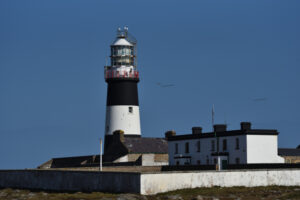
The lighthouse theory speculates that there must have been someone or a group of people bearing ill intent towards the crew of the HMS Wasp.
Tory had a large Fenian element among the population, including the elected ‘king’ of the island, a man called Heggarty, who along with many on the island had feared that the Wasp was on route to Tory for evictions rather than Inishtrahull. Perhaps Heggarty and the islanders were intent on resisting any evictions that might be planned.
What we do know from survivor reports is that the lighthouse light was on after the collision, but could it have been switched off before the Wasp struck the reef?
Some speculate that given the navigational skills of lieutenant Nicholls it is unlikely that the ship would have crashed if there had been a proper light source such from Tory.
Some speculate that a skilled navigator like lieutenant Nicholls would not have crashed there was a proper light source such from Tory.
Lieutenant Nicholls was also a well-respected seaman with a track record of successfully navigating the dangerous waters of the north west, and this was reinforced by a resolution passed by the piers and Harbour’s commissioners’ days after the disaster:
“Today at a meeting of the piers and harbours commissioners held at the castle, Col Nolan MP in the chair, a resolution was passed expressing the regret of the commissioners at the death of Commander Nicholls and of his officers and crew of the Wasp and bearing testimony to the care skill and efficiency with which the vessel was navigated by Commander Nicholls during the recent inspection of commissioners on the west coast of Ireland”. (8)
The fact that the lighthouse light was never mentioned at the court martial does suggest that it did not play a major role in the sinking of the Wasp. So, while the ‘Lighthouse theory’ that the light was deliberately runed off, has its adherents, there appears to be no hard evidence of any conspiracy to do this.
Was it a curse?
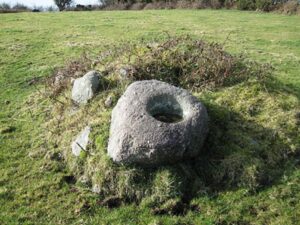
One other theory, or perhaps local folklore, is that HMS Wasp was sunk through the use of the Tory Island ‘cursing stone’ once again by islander’s fearful of a future eviction themselves.
Tory did indeed have such a stone at the time called ‘Cloch na Mallacht’ or ‘Cloch Thorai’. Folklore links the stone to St Colmcille and the pilgrimage route around the island ‘An Turas Mor’.
Pilgrims would visit the numerous holy sites on Tory and then at the end of their walk they would defiantly turn the cursing stone upside down. However, a curse could be invoked if the pilgrimage route was done in a counter clockwise direction. Folklore notes that such a curse helped defeat an earlier invading English raiding party in the early 1600s during O’Doherty’s Rebellion of 1608. (9)
Local tradition had it that the ship, set to carry out evictions, fell victim to a local curse.
But whether one believes in curses or not, one fact we do know is that the cursing stone disappeared shortly after the sinking of the Wasp. The local priest Fr Michael O’Donnell had it removed, and to this present day, no one knows, or perhaps is willing to tell, where it is. (10)
Conclusion
The Admiralty court martial did not blame any one person in particular for the loss of the Wasp but instead pronounced the tragedy was:
“In consequence of the want of due care and attention”
I tend to believe that three factors contributed to the sinking oi the Wasp.
The unpredictable weather
The waters of the North Atlantic off the coast of Tory are notoriously dangerous and despite the forecast mild weather, hours before the Wasp sank, another tragedy took place when a local fishing boat capsized just miles from Tory. A boat containing three local fishermen capsized near the area where the Wasp went down and two of the men drowned, Morgan Sweeney and Hugh O’Donnell. The brother of Hugh O’Donnell managed to swim to shore.
Inexperience and negligence
While there is no disputing the evidence that Lieutenant Nicholl was an experienced navigator, who had great knowledge of the waters around Tory, he was in bed asleep when the boat sank. The officer of the watch was completely unaware of the dangers that lay ahead. Could a more experienced sea man have perhaps steered the ship to safety?
Complacency
The Wasp was under sail when she sank. She would have had more manoeuvrability and speed if she had been utilising her steam engines. Was the fact she was under sail complacency or perhaps a cost cutting exercise?
These three factors, all with evidence to back them up, are far more powerful reasons for the sinking of HMS Wasp than a Tory conspiracy or a curse. However, no matter the reason for the sinking we must remember the 52 men who lost their lives in this tragedy.
Over the next few weeks after the sinking, bodies of the deceased came ashore across the Donegal coastline and many are buried in many local graveyards from Gweedore to Malin Head.
Over the next few weeks after the sinking, bodies of the deceased came ashore across the Donegal coastline and many are buried in many local graveyards from Gweedore to Malin Head. A monument was later erected on the mainland in the church yard of St Ann’s Church of Ireland in Killut, where several crew members are buried.
This is a most poignant memorial, as it looks out to Tory and the site of the sinking of HMS Wasp, which never did help evict poor Irish farmers from their homes on Inishtrahull.
The islanders of Inishtrahull, were reprieved from eviction, and remained on the island until 1929.
It may be best to conclude with a tribute to the men of HMS Wasp from the Society of Friends in a letter to the Belfast Morning News 24th September 1884.
“Sir, in reference to the sad calamity that has occurred to HMS Wasp off Tory Island, we are honorary secretaries to the fund promoted last year by the society of friends for supplying potatoes to the distressed peasantry of County Donegal desire to express our deep feelings of regret at the disaster.
For several weeks during the spring of 1883, we and other members of the committee were more or less engaged in sailing around the dangerous coast of Donegal chiefly in the Wasp and in her twice visiting Tory Island. In memory of Lieutenant Commander Nicholls and those under him we wish to recall the kindness, courtesy and the zeal they displayed in the efforts made to relieve distress, the men willingly undergoing much hard work and dirty work in loading and unloading the vessel.
Great sympathy will be felt towards the relatives of those that are lost especially so by the committee and the subscribers of the fund we have mentioned, and we feel sure that in the cheerless cabins of Donegal will arise a profound feeling of regret at the sad fate of those who did much to help them in their time of need”.
Yours truly
John Pim and John Marsh Society of Friends (11)
Sources
- Dawlish Chronicles
- Belfast Morning News 25th September 1884
- Belfast Morning News 25th September 1884
- Belfast Morning News 25th September 1884
- ie
- Belfast Morning News 25th September 1884
- Press Association September 1884
- Belfast Morning News 25th September 1884
- Jonathan Bardon. The Plantation of Ulster. Gill & MacMillan, 2012.
- Tory Island and the Cursing Stones Daily Scribblings.com
- Belfast Morning News 25th September 1884